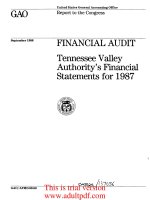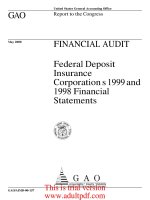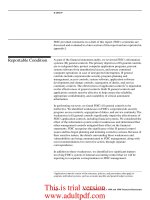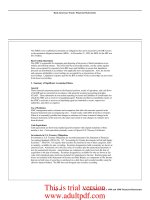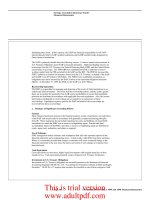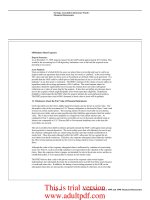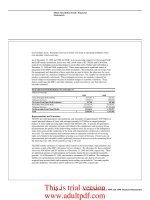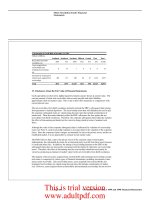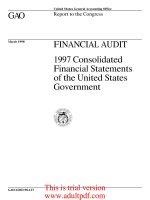United States Report to the Congress FINANCIAL AUDIT Examination of Customs’Fiscal Year _part2 potx
Bạn đang xem bản rút gọn của tài liệu. Xem và tải ngay bản đầy đủ của tài liệu tại đây (869.33 KB, 10 trang )
B-252376
money, or how much, for two of its largest accounts receivable categories.
In addition, Customs’ efforts to collect what was owed were compromised
by missing documentation needed to support the amounts owed. Further,
its ability to collect amounts due the U.S. government was also limited by
l
delayed final determination of Customs duties-in many cases more than 1
year after the release of the imported merchandise;
. lack of controls to assure that bonding requirements for importers were
sufficient to protect against their failure to pay;
l
long delays in processing supplemental duty bills protested by importers;
and
l
failure to maintain adequate control over documents needed to collect
balances due and inadequate follow-up on amounts due.
As a result of our audit, Customs plans to change how it determines the
accounts receivable balance for September 30, 1993. Additionally,
Customs has begun to modify its methodology for estimating collectibility.
Customs recognizes the challenge it faces in collecting its receivables and
has begun efforts to improve its collection practices. Correcting these
problems will be difficult because Customs does not have financial
management systems in place that provide current and accurate
information on the status of its receivables.
Because of the severity of the problems that must be dealt with, it will take
a substantive effort by Customs’ management before it has reliable
information with which to monitor and evaluate its performance in
collecting receivables or determining how much the federal government is
owed and can reasonably expect to collect.
Seized Property
As part of its enforcement duties, Customs seizes property’ including cash,
lwcury automobiles, jewelry, illegal drugs, firearms, and other valuable or
potentially dangerous property. Although Customs had established
policies and procedures to assure proper accountability and stewardship
of these items, it did not always follow them. Internal control weaknesses
were evident throughout the seized property process, from the time
property is first seized until it is disposed of. Opportunities for these goods
to be stolen or misappropriated without detection were pervasive and
‘We have previously reported on various issues regarding seized/forfeited assets. Such reports include
Asset Forfeiture Programs (GAO/HR-93-17, December 1992); Asset Forfeiture: Customs Reports
Improved Controls Over Sales of Forfeited Property (GAOICTGD-91-127, September 26,199l); and
Oversight Hearings on Asset Forfeiture Programs (GAOfI’-GGD-90-56, July 24,199O).
Page 10
GAO/AIMD-93-3 Customs’ 1992 Financial Statements
This is trial version
www.adultpdf.com
B-262376
such occurrences could result in financial loss to the government or
danger to the general public.
In preparing its financial statements, Customs made net a&rstments of
about $281 million to its fiscal year 1992 seizures amount and net
adjustments of $52 million to its September 30,1992 seized property
inventory. However, Customs could not provide us with support for the
adjustments. After making the adjustments, Customs reported $542 million
in seizures during fiscal year 1992 and an ending balance of $489 million in
seized property in the notes to its Principal Statements as of September 30,
1992.
Customs’ records to control, manage, and report seized property were
incomplete and inaccurate. Specifically, these records (1) did not include
large quantities of seized property, (2) showed incorrect location data for
some items, (3) included erroneous values, such as those for counterfeit
items, and (4) included seizures and forfeitures that occurred in another
ffical year. For example, we found several instances of drugs that were on
hand that were not in the seized property records. Also, our analysis of the
value of property seized in ftscal year 1992, as recorded in the seized
property records, showed that Customs overstated this amount by about
$138 million. This amount was overstated because Customs included items
for which it never took possession. In addition, our analysis of about half
of the recorded value of fiscal year 1992 seizures for which Customs took
possession and seized property on hand as of September 30,1992, showed
these amounts to be overvalued by approximately $217
million
and
$113 million, respectively.
With regard to safeguarding seized property, Customs often used weak
and inconsistent procedures. We noted such specific problems as
. delayed transfer of confiscated property from seizing officers to
custodians;
l
seized drugs not being properly weighed and tested;
.
delayed deposits of cash or deposits in non-Treasury accounts with
insufficient insurance or collateral protection; and
.
storage facilities not properly protected, for example, open physical
access, no security cameras, and insufficient control over access by
personnel.
Page 11
GAOhUMD-93-3 Customs’ 1992 Financial Statements
This is trial version
www.adultpdf.com
B-252376
Given the wide-range of control weaknesses noted and the significant
errors that we found, Customs will have to make a substantive effort to
ensure that seized property records are accurate and complete.
Property
Customs is responsible for managing and reporting its property, plant, and
equipment, which is valued in the financial statements at $710 million.
Approximately 85 percent of this amount consisted of equipment, such as
aircraft, vehicles, and vessels. Some of this equipment contains highly
sensitive detection and surveillance items used by Customs in its drug
enforcement activities.
The values for these assets were based on property and accounting
records that were unreliable, and the assets themselves were not
adequately safeguarded against theft or misappropriation. We found that
Customs (1) was unable to reconcile its accounting records and related
detailed property subsidiary records to ensure that all property items were
properly accounted for and valued, (2) did not perform physical
inventories of all nonequipment items and performed ineffective physical
inventories of equipment, and (3) was unable to support the values
assigned to property, primarily because, for many items, appropriate
procurement documents were not available and, in some instances,
Customs used unrealistic estimates. For example, Customs could not
provide documentation to support values totaling over $9 million assigned
to 335 of the 706 items we tested. In addition, as a result of our analysis of
all property records in the property system, we found 735 instances in
which the assigned values for equipment items appeared to be estimates.
Further, Customs’ property records (1) did not include all property items
on hand, (2) included lost or disposed property items, (3) included
property with erroneous or unsupported values, and (4) did not include all
costs related to developing software in-house, which can be worth millions
of dollars.
Customs has taken steps towards resolving long-standing problems in its
property records and is planning additional efforts. For instance, as part of
Customs’ Office of Information Management Fiscal Year 1993 Project Plan,
Customs plans to determine the costs for all existing software that had
been developed in-house and develop procedures to account for these
costs for all ongoing activities.
Page 12 GAOAIMD-93-3 Customs’ 1992 Fhmncial Statement.9
This is trial version
www.adultpdf.com
B-252376
Revenue
Customs relies to a great extent on importers/brokers to voluntarily report
and assess the amount of duties, taxes, and fees owed on imported
merchandise. We reviewed Customs’ revenue processes from the time
merchandise arrived at U.S. borders until it was entered into U.S.
commerce for consumption. We found no significant internal controls to
ensure that merchandise entering the United States was identified and the
proper duty assessed. Due to vast quantities of import activity and a poor
internal control environment, we could not reasonably test whether
dutiable merchandise that entered the United States was identified and the
proper duty assessed.
Based on our tests of individual revenue transactions, such as duties,
taxes, and fees owed, and the collection and classification of amounts
paid, we concluded that the reported $20.2 billion of total revenues
approximates revenues collected from importers who voluntarily reported
and paid amounts owed. However, because of the potential for goods to
enter and not be identified, we cannot give any assurance that the reported
$20.2 billion represents all revenues which Customs should have collected
for fscal year 1992.
Also, Customs is the initial source of information for international trade
statistics on imports used in monitoring and formulating trade policy.
Thus, to the extent that Customs’ information may be in error, trade
statistics could also be misstated. While Customs recognizes these
weaknesses and has established a project to improve importer compliance
and target inspections for trade enforcement purposes, it will take a
significant effort to adequately address the broad scope of problems in this
area.
Drawbacks
Customs makes refunds to ckximants for 99 percent of duties paid, when
the related imported merchandise is subsequently exported or destroyed.
These refunds are known as drawbacks. Of the $775 million Customs
reported as refunds and drawbacks expense, $496 million were drawback
payments Customs made during fiscal year 1992.
We found serious control weaknesses at all stages of the drawback
process. Customs did not (1) adequately assess the validity of a drawback
claim and track the amount of drawback paid against an import entry,
(2) establish sufficient review procedures to ensure that a claim was
accurate, (3) ensure that required bonds were adequate, and (4) ensure
Page 13
GAOIAIMD-93-3 Customs’ 1992 Fiieial Statements
C’P
This is trial version
www.adultpdf.com
B-262376
that only authorized claimants received accelerated2 drawback payments.
These weaknesses create an environment where the federal government
could lose millions of dollars.
As a result of Customs not having internal controls to prevent and detect
duplicate or excessive drawback claims and the large volume of import
documents associated with drawbacks, detailed testing was impractical.
Customs reported 53,000 drawback claims in fiscal year 1992. Each claim
may be associated with a number of separate entries. For example, one of
the drawback claims in our limited sample had 957 associated entry
summary documents. Because we were unable to test whether drawback
payments made in fLscal year 1992 were valid and did not exceed
99 percent of the original duties paid, we cannot give assurance that the
reported $496 million represented valid claims.
Customs did not have an automated system that (1) links drawback
payments to entry summari es and (2) maintains information about a
claimant’s filing history. The inadequate systems and control weaknesses
discussed above increase Customs’ vulnerability to lost federal funds.
Although Customs had plans to revise the drawback and revenue systems,
the drawback revisions were given a low priority. Until these weaknesses
are corrected, the potential for fraudulent and other invalid payments
occurring will continue.
Accounts Payable
Customs had no assurance that reported accounts payable of $73 million
as of September 30,1992, included amounts actually owed. Customs’
financial management systems were designed to record accounts payable
only when both the goods or services and an invoice had been received.
Therefore, liabilities were routinely not recorded for goods or services
received until an invoice had been received and processed.
At yearend, Customs used special procedures to identify and record
accounts payable for which goods and services had been delivered as of
September 30,1992, but the invoice had not yet been received. However,
Customs could not provide information necessary for us to test whether
all payables as of September 30,1992 had been identified. Further, our
limited testing of payables Customs identified found that the reported
amount may be overstated due to amounts being recorded for goods and
services not received in fiscal year 1992.
2Accelerated drawback payments are made to authorized claimants prior to Customs reviewing and
verifying the validity and accuracy of the claim. Nonaccelerated claims are paid after Customs reviews
them. Therefore, accelerated payments represent a greater risk than nonaccelerated payments.
Page 14 GAO/AIMD-93-3 Customs’ 1992 Financial Statements
This is trial version
www.adultpdf.com
B-262376
Also, we found that Customs’ monitoring controls over contracts were
weak. Specifically, we found instances where Customs’ contracting
officers and technical representatives approved payments on contracts
without verifying the validity of the charges by comparing them to the
goods or services received. This lack of verification makes Customs
vulnerable to fraudulent or overstated charges being submitted and paid
without detection.
Intragovernmental
Receivables and
Reimbursable Services
Retained
Improper accounting procedures and weak controls over interagency
agreements3 resulted in Customs misstating amounts owed and reimbursed
by other government agencies. We could not determine whether the
reported $72 million in intragovernmental receivables nor the related
$307 million in reported reimbursable services and user fees retained were
correct or reported in the period the goods or services were provided to
the other agencies.
We found that Customs did not (1) follow its own guidelines for recording
interagency agreements, (2) maintain records to support amounts
reimbursed by other agencies, (3) properly record and report its available
budgetary resources4 with respect to interagency agreements, and (4) bill
and collect amounts owed from other agencies based on delivered goods
or services.
Customs recognized that it had problems accounting for interagency
agreements and took steps to correct them. Customs hired an accounting
firm to perform a detailed review of certain interagency agreements to
determine if amounts owed were appropriate based on what portion of the
goods or services called for in the agreement had been provided. This
review resulted in a $96 million downward adjustment to the
intragovernmental receivables and reimbursable services retained, leaving
reported balances of $72 million and $307 million, respectively. However,
Customs could not identify how much of the $96 million pertained to fiscal
year 1992, and the accounting firm agreed that a portion of the adjustment
was attributable to prior years. Thus, the reported balance for
%teragency agreements provide a mechanism for an agency needing supplies or services to obtain
them from another agency (the servicing agency). Generally, the requesting agency reimburses the
servicing agency for the cost of providing the goods and/or services.
tiMB apportions the amount of budgetary authority available for interagency agreements at the
beginning of each fiscal year based on an estimate of the total value of agreements in which Customs
will participate. Upon signing an agreement (as the servicing agency) Customs has budgetary
resources available for obligations needed to fulfill the agreement. Certain budgetary resources that
remain unobligated at year-end will be carried over to the next year.
Page 16
GAO/AIMD-93-3 Customs’ 1992 Financial Statements
e, /’
This is trial version
www.adultpdf.com
B-252376
reimbursable services and user fees retained is likely to be understated to
the extent that it was reduced in fiscal year 1992 for amounts that related
to earlier years.
In addition, overstatement of certain amounts owed by other agencies to
Customs resulted in Customs reporting Slated unobligated budget
resources. These amounts carry forward into future years and appear as
budget authority available to cover future spending by Customs.
Consequently, Customs’ improper budgetary accounting for these
interagency agreements caused amounts reported to its program
managers,
OMB,
and others as available budget resources to be incorrect.
Unliquidated Obligations
Under federal accounting requirements, obligations are initially recorded
based on a contract or other formal order for the acquisition of goods and
services. During the course of the year, obligations are to be reduced
(liquidated) upon receipt of the goods or services ordered. At this point,
budget authority is said to be expended. When budget authority is
expended, the related obligation is liquidated and the appropriation is
charged with the actual costs of items received.6
Customs did not ensure that (1) obligation balances were reduced for the
cost of goods and services received, (2) obligations incurred reflected
reasonable estimates of spending levels, and (3) unneeded obligations
were deobligated in a timely manner. We also found that obligations were
often misclassified in Customs’ accounting records. Customs’ failure to
record expended appropriations or deobligate funds in a timely manner
misstated Customs’ funding needs. Consequently, Customs managers and
other decisionmakers were not provided with accurate information. In
addition, it eliminated the potential for these funds to be reprogrammed
within its appropriations.
Customs’ reported unliquidated obligations of $361 million were
approximately 25 percent of its fiscal year 1992 appropriation.6 Of the 102
unliquidated obligation balances we reviewed, approximately 42 percent,
or $83 million of the total value of the sample, should have been
deobligated or expended. In addition, Customs could not provide support
for 17 unliquidated obligation balances totaling $7.3 million.
60bligations remain available for expenditure until the related goods and/or services have been
received.
‘This includes Customs’ general and special funds which can be used to fund its operations.
Page 16 G4O/AIMD-93-3 Customs’ 1992 Financial Statements
This is trial version
www.adultpdf.com
B-252376
FMFIA
An indication of Customs’ failure to promptly expend funds upon receipt
of goods or services was further corroborated when Customs identified
over $70 million of unrecorded accounts payable in conducting its
year-end procedures. The scope of our work on unliquidated obligations,
as in accounts payable, was limited due to the lack of underlying support
needed to determine that accounts payable were properly stated.
Therefore, we could not affirm that the reported balance was properly
Stated.
Customs did not disclose the overall severity of its internal control and
accounting system weaknesses in its report to Treasury on its
conformance with FMFIA objectives. Without adequate disclosure, users of
the FMFIA report will not be aware of the extent of Customs’ weaknesses
and the efforts needed to correct them. We found material weaknesses
that Customs either did not include or did not adequately disclose in its
fiscal year 1992 FMFIA report. For example, while Customs reported that its
accounting system cannot properly age and estimate collectibility of
accounts receivable, it did not disclose that its systems contain incomplete
and inaccurate receivables information. Also, Customs reported that the
interface between its accounting system and detailed property subsidiary
records is inadequate and inconsistent but did not disclose the extent of
the weaknesses in controls to ensure that information maintained in these
records was accurate.
In addition, some previously identified material weaknesses that Customs
reported as corrected, including accrual accounting for liabilities and
accountability over seized currency, still existed because Customs did not
ensure that corrective actions were effective. These weaknesses seriously
eroded Customs’ ability to safeguard, manage, and control its import
revenues and operating expenditures.
Chief F’inancial Officer’s
Role
Management of the Customs Service is one of 17 program areas identified
by us as being at high risk to waste, fraud, abuse and mismanagement7 For
years Customs did not have a management structure that included a Chief
Financial Officer (CFO) with the necessary credentials nor authority of the
sort now provided by the CFO Act. The absence of an effective CKI
structure in Customs resulted in (1) automated data processing
(ADP)
systems that were developed with little or no consideration given to
7Managing the Customs Service (GAOIHR-93-14, December 1992).
Page 17
GAWAIMD-93-3 Customs’ 1992 Financial
Statement8
“*
This is trial version
www.adultpdf.com
B-262376
reporting financial information and (2) in many instances, no policies or
procedures designed to ensure that reported information was reliable.
Over the last 2 years, since the passage of the CM) Act, Customs has put in
place a CFD structure and given the CFO the authority and responsibility
necessary to begin to correct many of the problems identified in our audit.
However, the depth and number of the problems found is such that it will
take a concerted effort and sustained commitment by Customs’
CFC
and
senior management to correct them. In this same light, the success of
Customs’ ongoing
ADP
system modernization efforts, and particularly its
Automated Commercial System
(ACS)
redesign effort, will be critical to
improving Customs’ financial management systems and internal control
structure. It will take the combined impact of the CFO structure and
successful implementation of its system modernization efforts to enable
Customs to produce useful information on its operations that
decisionmakers, such as the Congress and the agency’s senior
management, can rely on.
Objectives, Scope,
Management is responsible for
and Methodology
. preparing annual financial statements in conformity with applicable
accounting principles,
l
establishing and maintaining internal controls and systems to provide
reasonable assurance that the broad control objectives of FMFIA are met,
and
l
complying with applicable laws and regulations.
We are responsible for obtaining reasonable assurance about whether
(1) the Principal Statements are reliable (free of material misstatements
and presented fairly in conformity with applicable accounting principles)
and (2) relevant internal controls are in place and operating effectively.
We are also responsible for testing compliance with selected provisions of
laws and regulations and for performing limited procedures with respect
to certain other information appearing in the annual financial statements.
In order to fulfill these responsibilities, we attempted to
.
examine, on a test basis, evidence supporting the amounts and disclosures
in the Principal Statements;
. assess the accounting principles used and significant estimates made by
management;
Page 18
GAO/AIMD-93-3 Customs’ 1992 Financial Statement.8
1
:i, I
This is trial version
www.adultpdf.com
